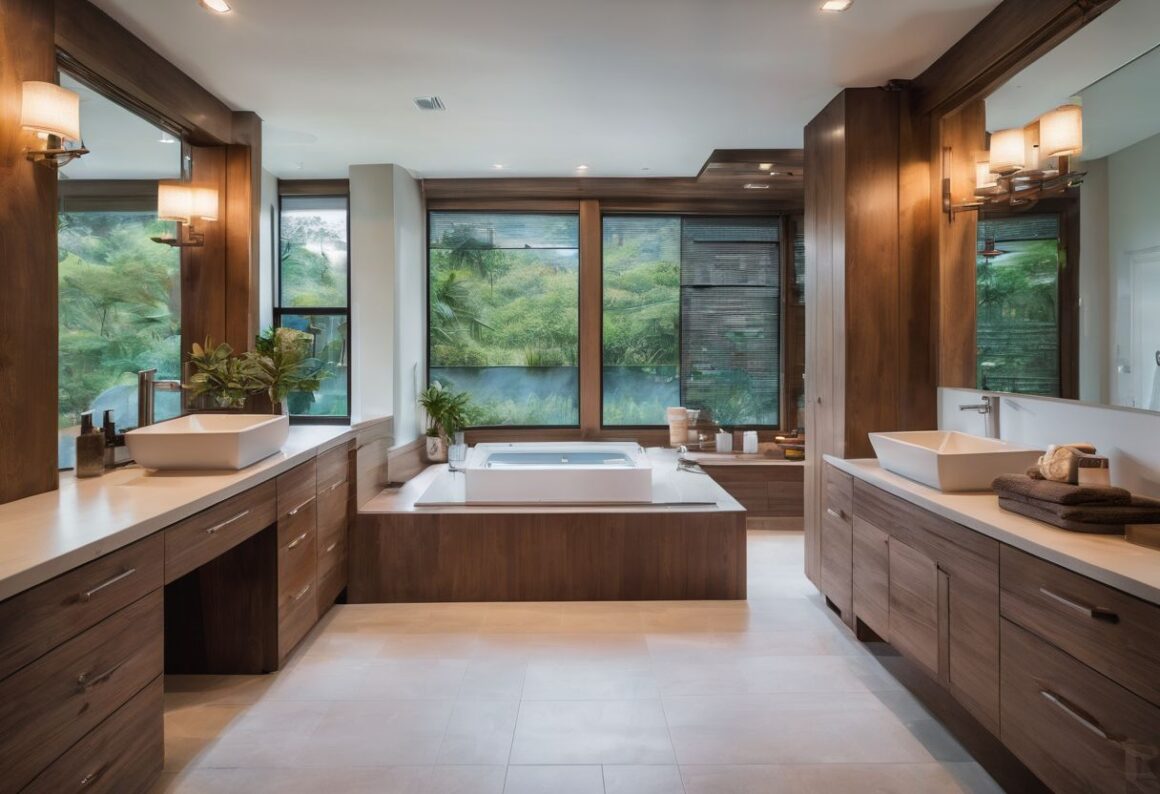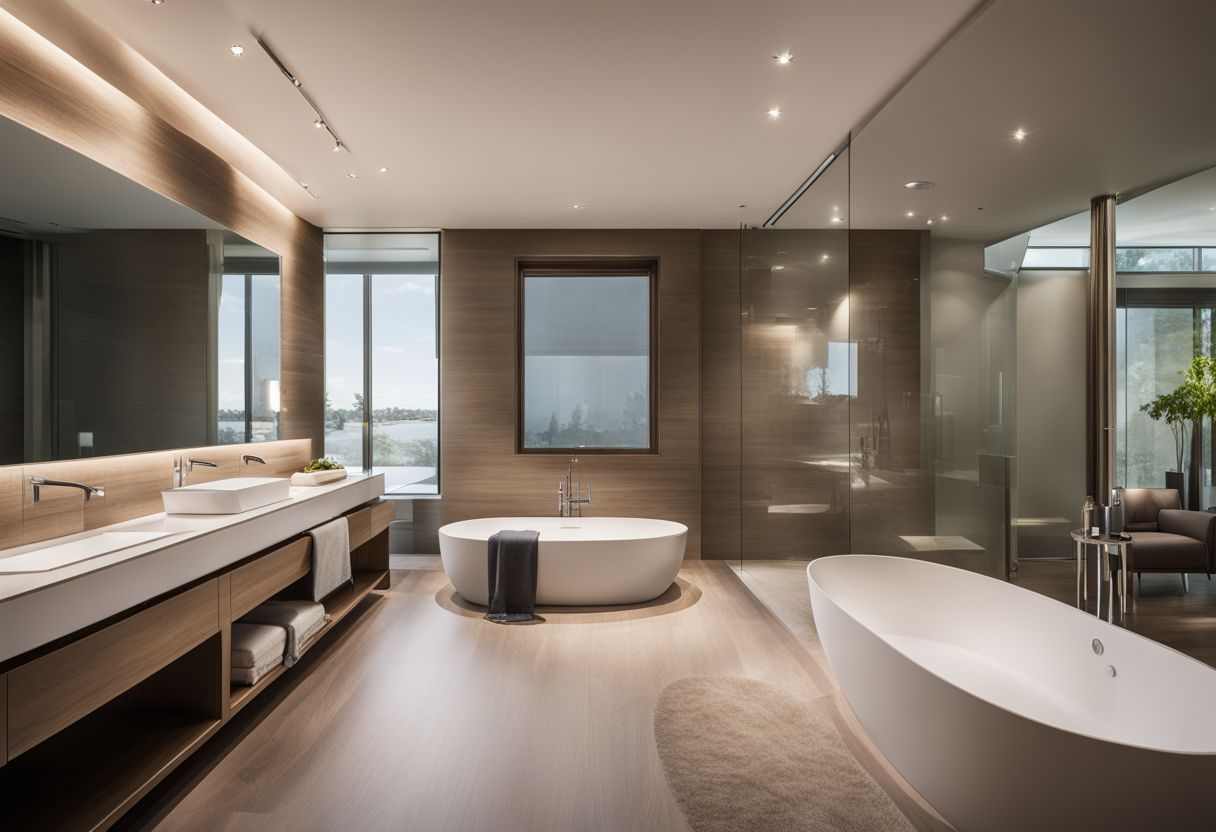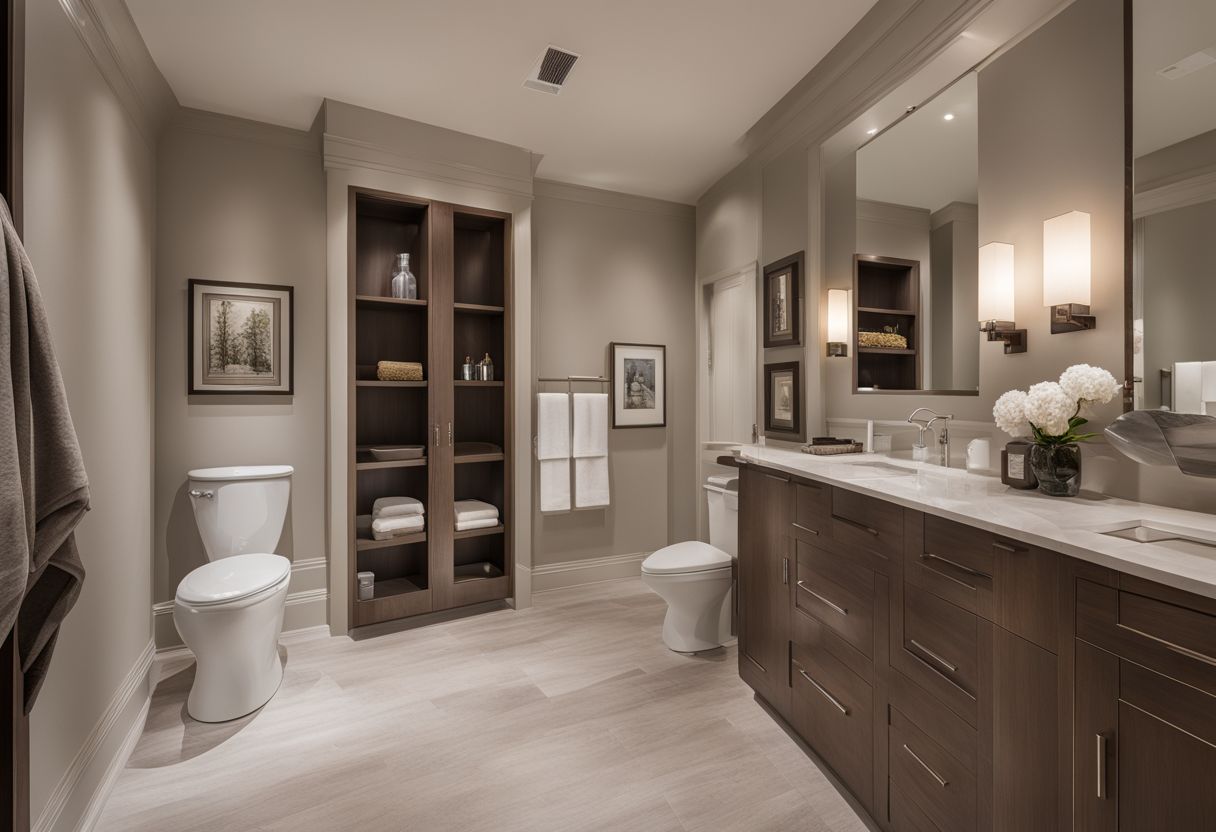Have you ever felt cramped in a tiny bathroom, bumping elbows on the walls? The recommended toilet room size for comfort is 30 inches wide. This post will guide you to create a toilet space that feels just right, ensuring everyday use is both comfortable and convenient.
Keep reading—space matters!
Standout details
- A good toilet room should be at least 30 inches wide for comfort, and the ADA requires a width of at least 60 inches for wheelchair access.
- You need enough space around your toilet—aim for at least 21 inches in front of it and keep it no closer than 15 inches from any wall or fixture on either side.
- Pocket doors can save space in small bathrooms because they slide into the wall instead of swinging open.
- Taller toilets, often called “comfort height,” are better for older adults or those with mobility issues; standard toilets work well in spaces where saving room is important.
- ADA compliant toilets have specific requirements like seat heights between 17 to 19 inches and grab bars installed to help people with disabilities.
The Importance of Proper Toilet Room Size
Navigating the design of a toilet room might seem straightforward, but getting it right is crucial for everyday comfort. Ensuring there’s enough space not just satisfies building codes—it also paves the way for safe, accessible use that stands the test of busy mornings and relaxing evenings alike.
Comfort and convenience
Having enough space in your toilet room matters a lot. It makes using the bathroom easier and more comfortable for everyone. When there’s plenty of room, you don’t feel squished or like you’re stuck in a tight spot.
This is especially true for ease in sitting down and standing up if you use a comfort height toilet.
Good design lets people move around without bumping into things. Think about when someone needs to open the door – they’ll want enough space behind them so it doesn’t hit their knees! Plus, having extra space near the sink means you won’t get water everywhere when washing your hands.
So, thinking about size and layout helps make sure your bathroom works well and feels great to be in.
Next up, let’s talk about what keeps everyone safe while they use the bathroom – accessibility and safety are key!
Accessibility and safety
Making a toilet room easy to move around in is very important. It makes sure that everyone, including people with wheelchairs or other needs, can use the bathroom safely and easily.
A good toilet room must have enough space for comfort and safety. This means having at least 60 inches of width for wheelchair access as required by ADA rules.
A safe toilet room helps stop accidents and makes sure all users are happy. Unisex toilets can solve problems when men’s or women’s rooms are not accessible. Everyone deserves a bathroom that gives privacy, dignity, and is easy to use without getting hurt.
Keep these things in mind so your home is welcoming and safe for anyone who visits or lives there.
Compliance with building codes
Building codes are key to making sure your toilet room is safe and follows the law. These rules help with things like how much space you need around a toilet, where fixtures can sit, and keeping enough room for people to move easily.
For example, you must keep at least 15 inches from the middle of the toilet to any wall or other fixture on either side. This way, everyone can use the bathroom comfortably.
The ADA sets clear rules too so that people with disabilities have enough space in a toilet room. To follow these standards, restaurants must have at least one stall made just right for disabled individuals.
All this planning makes sure that every person can access and use restroom facilities without trouble.
Factors to Consider When Determining Toilet Room Size
When plotting out your throne room’s dimensions, a host of factors come into play.. beyond just squeezing in the commode. You’re balancing building codes with comfort, ensuring there’s elbow room to move and that every inch works harder than a one-armed wallpaper hanger.
Minimum size requirements
Your toilet room needs enough space to be cozy and safe. Let’s look at what size it should be.
- The floor plan matters. Make sure your toilet has at least 21 inches of clearance in front of it. This lets you stand or move easily.
- A comfy toilet room is at least 30 inches wide. That’s from one wall to the other, giving you some elbow room.
- Don’t forget the space on each side. Aim for 15 inches from the center of your toilet to any wall or bathroom fixtures. This way, nothing’s too close.
- For small rooms, a minimum size is key. Your powder room should be no less than 15 square feet if it has only a toilet and sink.
- Think about ceiling height, too. You want enough overhead space so that the room feels open, not cramped.
- If you need a sink in there as well, leave some space around it for hand – washing and other tasks.
- People using wheelchairs need more room. So, ADA guidelines say make your water closet at least 60 inches wide.
- Lastly, check the length from back to front. Ideally, have a depth of at least 56 inches from the back wall to allow for ease of use and comfort.
Door placement
Picking the right spot for your toilet door matters a lot. You want to make sure people can get in and out easily without feeling squished. Think about how the door swings open and closed.
It should not hit the toilet or sink when it moves.
Doors are big, so you need enough room for them. If you have a tiny bathroom, consider sliding doors or ones that fold up against the wall. This way, you save space and still follow what building codes say for water closets.
Next up is floor space – let’s talk about how much of it you’ll need!
Floor space
Having enough floor space in your toilet room is key. You need room to move around without bumping into things. Think about the space in front of the toilet – you’ll want at least 21 inches of clear area, so you’re comfy and safe.
But don’t just think about right now; consider the future too! If someone in your family ever needs a wheelchair, you’ll be glad for extra space.
The size of most toilet rooms should be 3 feet wide by 5 feet long. This gives users lots of room to use and clean the bathroom without trouble. And if friends or family come over with special needs, like a wheelchair, they will find it easy to get around too.
So when planning your bathroom remodel or new build, keep these tips top of mind for everyone’s happiness and safety!
Ceiling height
Just like floor space sets the stage for a comfy bathroom, ceiling height adds to that feeling of openness. A higher ceiling can make even a small toilet room feel bigger. But don’t go too tall! Keeping the ceiling at 9 feet is just right—any taller, and it might not fit well with your home’s design.
Now, think about who uses your bathroom. Some people are over 6 feet tall and need a bit more space above. For them, toilets that are taller than 19 inches from top to seat work best.
They help everyone feel good using the toilet without any trouble or discomfort. Plus, it all ties together with making sure there’s enough room around the toilet for safety and ease.
Sink space
Sink space is key in a toilet room. It’s smart to pick a vanity that fits well and looks good. Most sinks are 16-24 inches wide and 20-24 inches deep. You need at least 15 inches of clear space around them so you can move easily.
If your master bathroom has a separate spot for the toilet, think about using a corner sink. This choice helps use every inch in the best way.
After sorting out where your sink will go, take a look at shower pan sizes next. This helps plan out the whole bathroom design better.
Shower pan sizes
Shower pans are like the floor of your shower, and they come in different sizes to fit your bathroom layout. You might see square shower pans that measure 32 inches by 32 inches, 36 inches by 36 inches, or even larger at 42 inches by 42 inches.
For a more stretched-out space, rectangular ones are popular – think sizes like 30 inches by 60 inches or up to 34 inches by 60 inches. Picking the right size matters because it helps make sure you have enough room to move around comfortably without water splashing all over the place.
In homes where several people live together, you’ll often find bigger showers. These might be wider or longer – with dimensions such as a spacious 36”x48”, or square types going all the way up to a roomy “48”x48″.
These larger pans can really make a difference in making your daily routine smooth and enjoyable. Now let’s talk about how two-piece toilets compare with one-piece models:.
Standard Toilet Room Sizes Based on Today’s Considerations
When navigating the world of toilet room dimensions, it’s crucial to strike a balance between modern space considerations and standard size guides; read on to discover how two-piece units differ from one-piece models, what ADA compliance entails for toilet spaces, and why sometimes going beyond the bare minimum can significantly enhance your bathroom experience.
Two-piece vs one-piece toilets
When it comes to choosing the right toilet for your bathroom, it’s not just about the flush. The distinction between two-piece and one-piece toilets can significantly affect the overall size and convenience of your toilet room. Below, we’ve laid out the differences in an easy-to-compare format:
| Feature | Two-Piece Toilets | One-Piece Toilets |
|---|---|---|
| Design | Separate tank and bowl | All connected, sleek design |
| Installation | Size and weight can make installation easier | Heavier and may require more effort to install |
| Space Efficiency | May take up more space due to separate components | More compact, saving valuable floor space |
| Cleaning | More crevices to clean around | Easier to clean with fewer crevices |
| Durability | Good, but more prone to leaks at the joining | Considered slightly more durable with fewer leak points |
| Finish and Style | Standard finishes | Offers higher-end finishes |
Selecting between two-piece and one-piece toilets hinges on balancing your space constraints and design preferences with practical considerations, like installation and maintenance. Remember, the choice you make will influence the comfort and functionality of your toilet room, so weigh these factors carefully.
ADA compliant toilets
Understanding the right dimensions for your toilet room can significantly impact the comfort and accessibility of your bathroom space. Especially important are ADA compliant toilets, which must meet specific standards to ensure that individuals with disabilities can use them with ease.
Here’s a quick guide to help homeowners understand the dimensions of ADA compliant toilets:
| Feature | Requirement | Description |
|---|---|---|
| Height | 17 to 19 inches | The ADA specifies this range for the height of the toilet seat to accommodate ease of use for individuals with disabilities. |
| Space Around Toilet | Minimum 60 inches diameter | This space allows for a wheelchair to make a 180-degree turn and provides sufficient room for assistance if necessary. |
| Grab Bars | Yes | Installation of grab bars is required for support and safety; these must be installed at specific heights and lengths according to ADA guidelines. |
| Flush Control | Maximum 44 inches from floor | Flush controls must be within reach for a seated individual and operable with one hand without tight grasping, pinching, or twisting of the wrist. |
| Clear Floor Space | Minimum 30 x 48 inches | This area must be clear of any obstructions to accommodate a forward or parallel approach by an individual in a wheelchair. |
| Lavatory Proximity | Accessible Route | The sink should be on an accessible route with a clear floor area to allow for easy approach and use. |
ADA compliant toilets are not just a consideration for public or common use facilities; they’re also crucial for homeowners who wish to create an accessible and comfortable environment for all users. This standard helps bring convenience and independence to individuals with disabilities, ensuring that the toilet room is a safe and user-friendly space.
Upgrading from minimum size to recommended size
Moving beyond the basics, let’s talk about making your toilet room bigger than just the smallest size allowed. It makes sense to aim for more space if you can. With a bit more room, everyone finds it easier to move around and use the bathroom comfortably.
The rules say there needs to be at least 21 inches of space in front of the toilet. But think about going up to 30 inches instead. You’ll really notice how much nicer it feels.
A larger area is also better for folks who may need extra room because they use wheelchairs or walkers. Plus, when you have guests over, they’ll appreciate the added comfort too! And here’s a tip: Giving your toilet 15 inches of space from any wall or other stuff next to it is good – but having even more than that is great! This way, you won’t feel squished and everything looks nice and open.
It’s not just about following rules; it’s about creating a bathroom that feels good to be in.
Tips for Maximizing Space in a Small Toilet Room
Squeezing comfort into a compact area might seem like a puzzle, but with smart design choices and tricks, your small toilet room can feel surprisingly spacious. Discover innovative solutions that transform tight quarters into functional elegance without compromising an inch of style – keep reading for these space-maximizing tips!
Choosing the right toilet design
Think about comfort and how much room you have. A taller, more elongated toilet is great if you’ve got the space. It helps most people to sit and stand easier. But, if your bathroom is tight, a round toilet might work better.
Door swings can get in the way, and round ones take up less room.
Look at size, height, and function too. For big bathrooms, an elongated bowl adds both comfort and style. Always check your toilet’s dimensions before buying to make sure it fits well in your space!
Utilizing space-saving features like a pocket door
Pocket doors are smart for small bathrooms. They slide into the wall, so you don’t need space for a door to swing open or closed. This means more room for things like cabinets, showers, and space to move around.
With a pocket door, your bathroom can feel bigger and work better.
You can add cool stuff with the extra space pocket doors give you. Think about a second sink or a big cabinet. Maybe even more room for clothes or towels! And because they hide away inside the wall, these doors make your bathroom look neat and tidy.
Adding amenities and utilizing vertical space
Make your small toilet room big with smart choices. Use tall, skinny shelves to get more space for towels and soaps without using up floor space. Try a pegboard on the wall for hanging plants or bathroom tools.
This way, things stay neat and easy to find. If you have a bit more room, put in some open shelves above the toilet or by the sink. You can keep extra rolls of toilet paper there or even some nice decorations.
Put a vanity that hangs off the wall to free up floor space as well. It looks cool and makes cleaning easier too! And don’t forget about hooking amenities like toothbrush holders or soap dispensers right onto the wall.
This keeps your countertop clear and gives everything a home so your bathroom feels tidy.
Common Questions and Concerns About Toilet Room Size
6. Common Questions and Concerns About Toilet Room Size:.
Navigating the nitty-gritty of toilet room dimensions can leave many scratching their heads—whether it’s understanding code nuances or ensuring your space melds convenience with compliance.
Let’s dive into common queries homeowners have, from selecting doors that swing the right way to picking a toilet that fits just so.
Toilet room dimensions by code and by comfort
Codes set the rules for toilet room sizes, but comfort decides how nice your bathroom feels. You need at least 21 inches of space in front of your toilet. Yet, for a more comfortable room, you might want 30 inches.
This way, you don’t feel squished while standing or moving around.
Your toilet should also fit the space right. Standard toilets are usually 27 to 30 inches long, but those extra-long ones go up to 31 or 32 inches. And leave enough room between the toilet and walls – a good rule is keeping it at least 24 inches clear to avoid feeling cramped.
For best results, aim for a spacious 36 inches so everyone can use it easily and safely.
Choosing the right bathroom door
Picking the right door for your bathroom is a big deal. You want it to be wide enough so people can easily walk through. The ideal width for comfort is 34 inches, but make sure there’s at least a clear opening of 32 inches.
Think about which way the door should swing open too—it must be safe and stick to building rules.
The type of door you go with depends on how much room you have and what your bathroom needs are. If space is tight, consider sliding or pocket doors that tuck away into the wall. They give you extra room and can look really sleek! Always choose a door that makes getting in and out simple, keeps you safe, and feels good in your home.
Factors to consider when choosing a toilet
Selecting a toilet involves more than you might think. It’s about comfort and your bathroom’s style, but it’s also about fitting the right size and shape into your space. You need to measure from the wall behind the toilet to get the rough-in size—most often 12 inches, though it can be 10 or 14 inches for some homes.
Make sure there is enough room all around—the space in front should be at least 21 inches and on each side no less than 15 inches.
Consider who will use this toilet too; taller toilets are great for older folks or anyone with mobility challenges. Check out different heights like standard or comfort height to see what feels best for you.
And look at shapes! Elongated bowls give more room while round ones save space—a key point when every inch counts in a smaller bathroom. Keep an eye out for features that meet accessibility standards if needed, ensuring safety along with a sleek design that matches your dream bathroom vision.
FAQs
1. What’s the minimum size for a toilet room?
The smallest size you can go for a toilet room is about 30 inches by 60 inches. This gives you enough space to fit in the toilet and lets you move around without bumping into things.
2. How much room should be in front of the toilet?
You’ll want at least 21 inches of space from the front of your toilet bowl to any wall or object. It’s like having room to stretch your legs – it keeps things comfy and safe.
3. Where should I put my toilet paper dispenser so it’s easy to reach?
Place your toilet paper holder about 8-12 inches in front of the bowl and about 26 inches up from the floor. That way, it’s right there when you need it, not too far, not too close!
4. What are standard toilet dimensions I should know about?
Standard toilets usually have a width of around 20-30 inches and depth from back to front around 27-30 inches; they fit well in most spaces and work great for day-to-day use.
5. How do I measure how much space a new toilet will need?
Start by measuring the distance from the back wall to where you want your new throne—this is called rough-in measurement—and add some extra space on each side so nothing feels squished!
6. Why does having enough room around my toilet matter?
Having more than just bare minimum clearances means fewer knocks and bumps—you’ve got plenty of elbows’ freedom! Plus, if space isn’t tight, everything looks better too: think design magic!

Alina Lee, a 35-year-old writer and horticulture enthusiast, brings nine years of expertise to the world of gardening writing. Her journey began with a solid foundation in agriculture, having graduated from Kansas State University in Manhattan, Kansas, with a degree in Agronomy. Alina’s academic background provides her with a unique perspective and a deep understanding of the intricacies involved in cultivating and nurturing plants.
With a passion for greenery and a commitment to sharing her knowledge, Alina has emerged as a prominent figure in the gardening community. Her articles not only reflect a wealth of experience but also a genuine love for the subject matter. Currently serving as a Senior Editor at Home and Around Blog, Alina plays a pivotal role in shaping content related to gardening and outdoor living.
Alina’s writing transcends mere information; it is a blend of practical advice, scientific insights, and a touch of inspiration for both novice and seasoned gardeners. Her commitment to fostering a deeper connection between individuals and nature is evident in her work. As a Senior Editor, Alina Lee continues to influence and inspire readers, contributing to the ever-evolving landscape of gardening literature with her extensive knowledge and passion for plant life.



